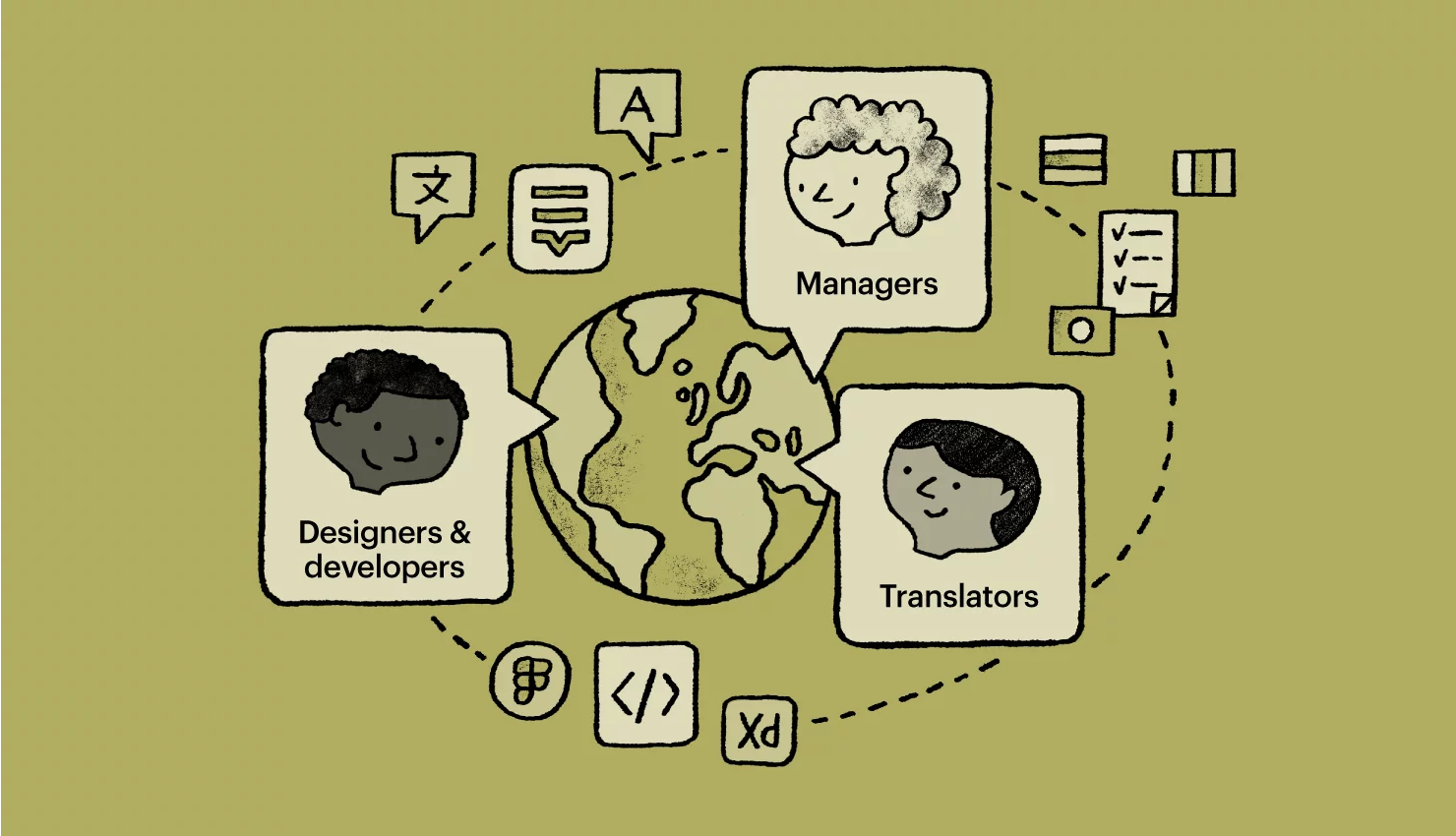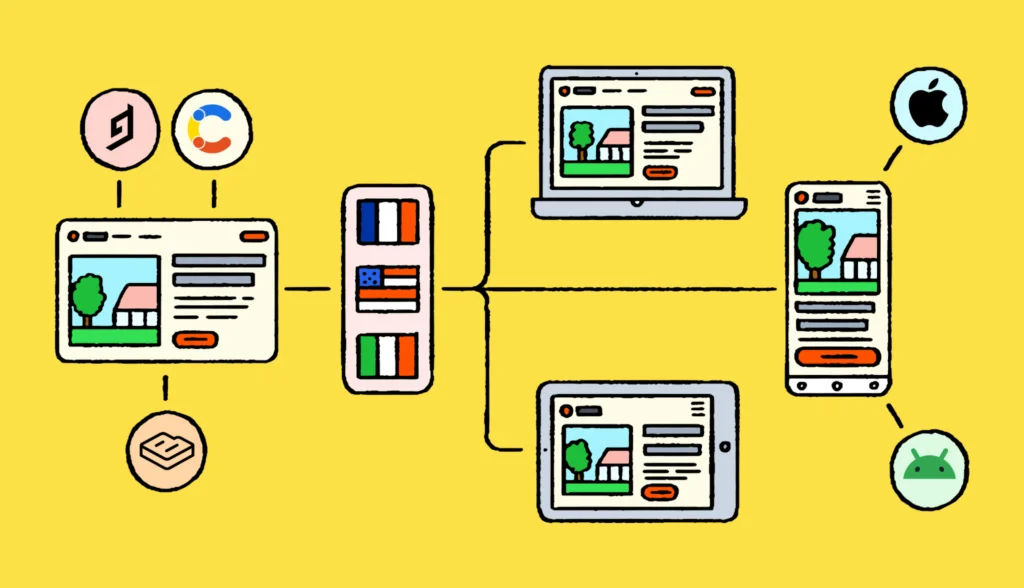In this article we are going to discuss remote work for cross-functional localization teams and some best practices. It is becoming increasingly apparent that we are not going to return to the same world that we knew before the global pandemic. Water cooler conversations, joint lunches and ad-hoc, quickly assembled meetings to achieve consensus and make critical decisions won’t be possible as companies are moving towards remote working or remote/office hybrid models.
Localization professionals that have been working in the language services industry are already much more accustomed to working remotely. Meanwhile, their counterparts who are working for companies that are localizing their products in-house, might find themselves in uncharted territory without face to face access to their developers or product and project managers that were usually available in the office.
Adapting to the new challenges of remote collaboration without jeopardizing the quality, efficiency, and delivery timelines of your software localization efforts, will require planning ahead and implementing tools that enable your l10n stakeholders to achieve speed and quality without meeting face to face.
Traditional remote collaboration tools are not sufficient
Collaboration tools like Slack, Google Meet, and shared online documents are important communication methods for remote teams. However, they cannot handle the complexity of continuous software localization and synchronous delivery of multiple software assets that modern, global companies typically localize.
You need multiple, purpose-built, integrated platforms, and localization teams need to be involved and follow the progress of the l10n project in real-time to ensure the right team has the right information at the right time. Your product quality and hitting market release deadlines depend on having visibility over this complex process.
Frequent, high quality multilingual product releases help growing businesses stay close to their global customer base, especially in times of uncertainty. To successfully deliver complex projects while working remotely, it is not enough to collaborate with shared documents and spreadsheets, and via virtual meetings. Hence you need a supporting tool that provides a structured, single source of truth so that you can focus on the items your teams need to work on.
Localization complexity is increasing
Modern, continuous software development practices require a high level of integration and collaboration between cross-functional teams. Adopting continuous software localization processes means that even more stakeholders are involved.
Developers, UI/UX Designers, Marketing Copywriters, Product and Project Managers, Localization Managers, and Translators are included earlier and throughout the software delivery lifecycle. To tackle the complexity this multidisciplinary l10n team must:
- Involve UI/UX design, marketing, and software engineering teams early in the project and automate many routine tasks to help them focus on the more important priorities and avoid late-stage rework and defects.
- Include textual and visual context along with the strings to help the team of linguists and increase translation quality.
- Provide visibility into the status of the project through dashboards, metrics, and reports to control costs and avoid missing release deadlines.
Four best practices for localization teams that work remotely
We have spoken to Lokalise customers who already have distributed localization teams and they have shared four best practices on how to adapt to remote work.
1. Establish a shared agreement on project timelines and deliverables
Teams need to align themselves on what they should focus on first, hence you should define expectations up front. Which countries or markets are you going to release first? Who are the stakeholders involved in the process? Which communication channels, tools and platforms are used and when? What are the success criteria for the business? Create a project brief and introduce the team to its contents at the beginning of each project.
2. Streamline decision making
Make sure to find a project manager that is able to onboard the team based on the motivation behind the project’s goal and how decisions are made. In this way, you will help them independently make better decisions further down the road. By defining clear responsibilities and explaining the “why”, your team will have higher situational awareness and comprehension of impact, and will feel empowered to initiate and resolve follow-up questions and issues. This is one of the main reasons that the localization project management role has become so creative. Localization programs constantly change and quick responses are imperative. Therefore, innovative processes have to be implemented, rather than just executing what’s in place.
3. Create a single source of truth for all translation strings by integrating a modern translation management system (TMS) into your localization workflow
There has been a tremendous increase in the scale and velocity of projects for companies that implement agile, continuous software development processes. Moreover, delivering modern, multi-platform products gives rise to more complex challenges that organizations face, as customers are increasingly demanding to receive high quality and regular updates.
To handle this complexity, companies must standardize their workflow whether they’re working with freelance linguists, LSPs, or in-house translators. Moreover, organizations need a way to experiment with the vendors without altering the workflow of the company. With more and more stakeholders involved in l10n processes, ensuring that their tools are integrated and that data flows into a single source of truth is paramount. Not only does it ensure that everyone is working from the same set of information, it also helps tie the project back to the business rationale and keep costs under control.
4. Collaborate with context
This might not seem obvious but could be the most important point on the list. How do you connect everyone on the team to relevant data that’s tied to the work? How do you avoid making decisions outside the process, such as in multiple shared documents or emails? Following the process will help speed up the decision process, reduce costly rework, improve quality, and ensure that teams hit development timelines and milestones. Many organizations never planned to have a remote, distributed team. Therefore staying aligned and maintaining quality, efficiency, or timelines could still feel like a challenge. Lokalise helps many global companies work seamlessly and successfully. Here are a few important notes on what facilitates collaboration between distributed teams:
- Intuitive technology — is user-friendly by design. It improves efficiency and momentum in a distributed team. Technology like this helps onboard team members, keep them aligned to projects, and connected to team members and their work. Many companies praise the UX/UI of Lokalise as being a user-friendly, intuitive platform that makes teams feel comfortable and empowered to deliver high quality results on time and on budget.
- Single source of truth — localization related data that flows through multiple integrated platforms should be accessible from a single place, ensuring that cross-functional teams work on the correct set of information.
- Real-time data sharing — the software localization process requires teams that work with structured, live data, especially when remote. Teams need to react fast and track change, which is necessary to collaborate with each other throughout the process.
- Automated workflows — everything starts with communication, nevertheless, this should be based on a foundation of integrated, automated workflows that help you prioritize and organize the content for localization.
- Project transparency — the localization manager, developers, UI/UX designers, marketers, and translators should be aware of the project’s status and important tasks and milestones despite boundaries like business functions, teams, and time zones. Therefore, communication channels in tools like Slack should be used to provide automated and continuous project updates to the entire team.




